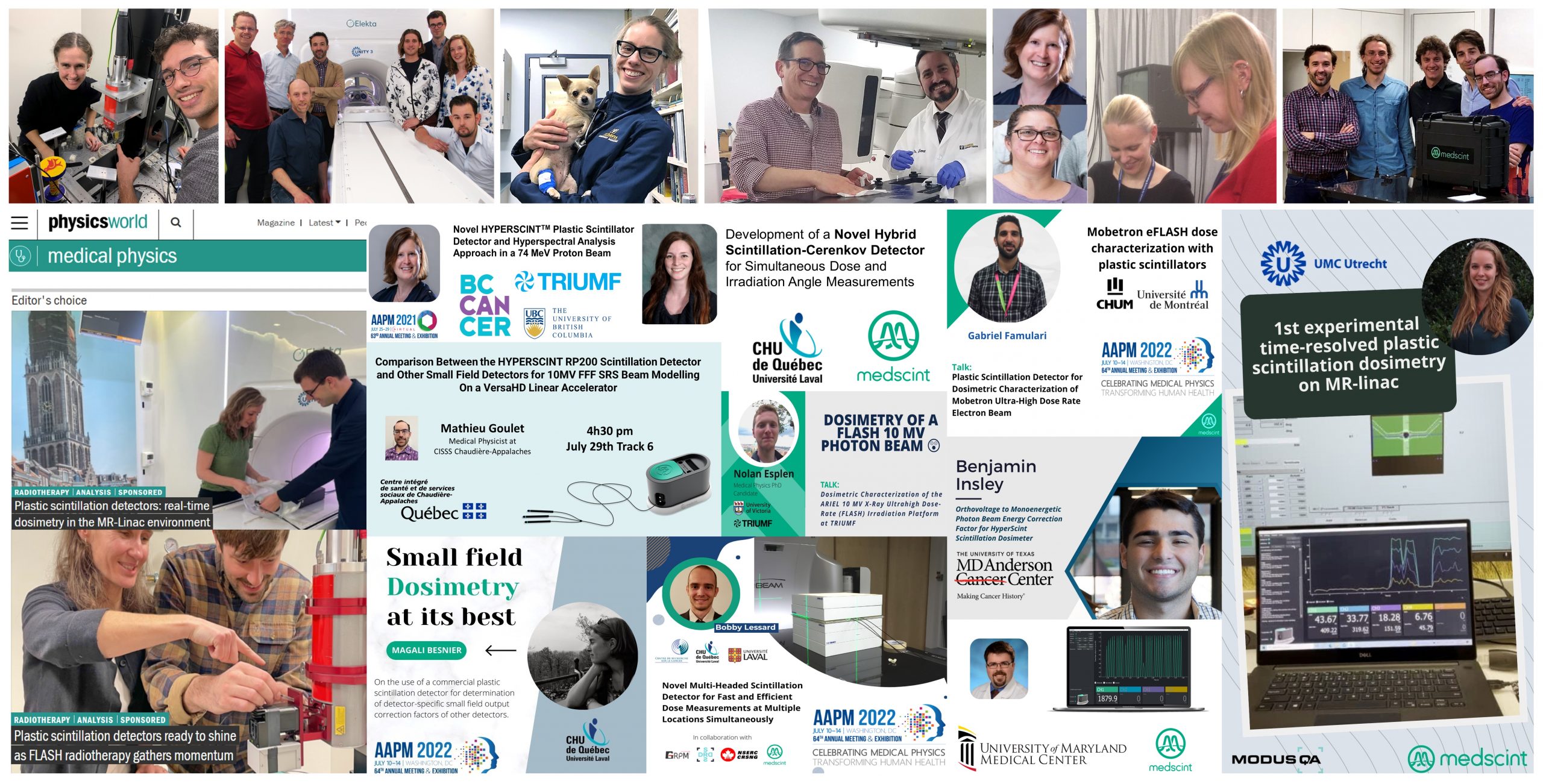
Characterization of a novel time-resolved, real-time scintillation dosimetry system (HYPERSCINT RP-FLASH) for ultra-high dose rate radiation therapy applications
This study evaluates a novel scintillation dosimetry solution developed by Medscint for ultra-high dose rate (UHDR) radiotherapy, the HYPERSCINT RP-FLASH. The system was tested on an UHDR electron beamline, demonstrating dose linearity and independence from dose rate (1.8–1341 Gy/s) and dose per pulse (0.005–7.68 Gy) within ±3% tolerance. The system accurately measured doses per pulse up to 120 Hz.
With daily calibrations and specific correction factors, the system provides real-time, millisecond-resolved dosimetric measurements for pulsed conventional and UHDR beams, showing promise for applications in FLASH-RT.
Characterization of a 0.8 mm³ Medscint Plastic Scintillator Detector System for Small Field Dosimetry
The scintillator-based dosimetry system HYPERSCINT RP-200, coupled with a 0.8 mm³ plastic scintillator detector, demonstrated excellent dosimetric properties for small field radiation therapy, including good repeatability, dose linearity, and accuracy down to field sizes as small as 0.5 × 0.5 cm².
Performance of the HYPERSCINT scintillation dosimetry research platform for the 1.5 T MR-linac
This study demonstrates the suitability of the HYPERSCINT PSD for accurate time- resolved dosimetry measurements in the 1.5 T MR-linac. The excellent performance during continuous MR scanning and during dynamic movement indicates the great potential of the detector to validate end-to-end workflows of online adaptive radiotherapy
Use of a Commercial Plastic Scintillation Detector for Determination of Detector-Specific Small Field Output Correction Factors of Other Detectors
The goal of this work is to determine small field output correction factors of various detectors using the HYPERSCINT plastic scintillation detector as a reference and to compare values with current available data. The simple and well understood composition and geometry of the scintillation detector make it ideal to be used as a reference detector for the evaluation of field output correction factors. Field size dependent correction factors have been extracted for different detectors and show limited discrepancies with current available data. This may potentially be attributed to inter detector variability or other methodological uncertainties in published data.
Plastic scintillation detectors ready to shine as FLASH radiotherapy gathers momentum.
The team of University of Victoria’s XCITE Lab are using plastic scintillation detectors to provide real-time, small-field dosimetry in their FLASH radiotherapy experiments.
First Experimental Demonstration of Time-Resolved Plastic Scintillation Dosimetry On An MR-Linac
In this study, UMC Utrecht research team demonstrates the feasibility of a hybrid experimental setup combining an innovative multipoint scintillator detector with film in a moving phantom quantifying MLC tracking for lung SBRT. The prototype cassette is capable of measuring dose (with film and 4 points scintillators simultaneously) during motion experiments, combining film dosimetry with time-resolved and absolute dosimetry.
Comparison Between the HYPERSCINT RP200 Scintillation Detector and Other Small Field Detectors for 10MV FFF SRS Beam Modelling On a VersaHD Linear Accelerator
Plastic scintillation detectors (PSDs) have advantageous dosimetric properties, including small size and energy independence, which make them ideal candidates for small field dosimetry.
Implementation and validation of beam current transformer for Mobetron ultra-high dose rate electron beam monitoring using multi-detector approach
To evaluate the performance of a custom beam current transformer (BCT) as a beam monitoring tool for the Mobetron electron radiation therapy system at ultra-high dose rates (UHDR) using a multi-detector comparison (plastic scintillators, ion chamber and film).
On the orientation independence of the HYPERSCINT scintillation dosimetry research platform in a MR-linac environment.
The purpose of this work was to characterize the HYPERSCINT scintillation dosimetry research platform in a MR-linac environment, particularly with respect to its orientation. This study shows that the HYPERSCINT scintillation dosimetry platform can be used regardless of its orientation in a magnetic field environment. Together with its linearity to dose and dose-rate, the detector shows great promises for development of dosimetry solutions dedicated to the MR-Linac environment.